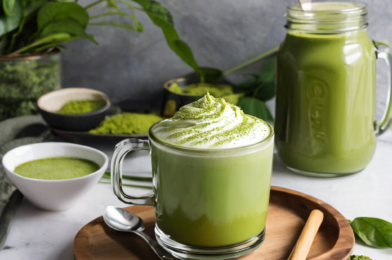As someone who enjoys exploring different beverage trends, the dairy-free matcha latte has been a delightful discovery. This vibrant green drink, rooted in centuries-old Japanese tradition, has recently surged in popularity for its health benefits and rich, earthy flavor. It’s not just about the aesthetic pleasure of its lush hue; the matcha latte offers a unique combination of taste and wellness, making it a favorite among many, including myself. My family, who are avid coffee enthusiasts, were initially skeptical about replacing their morning brew with something so different. However, after a few sips, they found themselves appreciating the nuanced flavors and the gentle energy boost that matcha provides. The combination of creamy plant-based milk and finely ground matcha powder results in a beverage that is not only satisfying but also nourishing, making it a staple in our morning routine.
Ingredients
The beauty of a dairy-free matcha latte lies in its simplicity and the quality of its ingredients. Here’s what you’ll need to make a perfect cup:
- 1 teaspoon of matcha powder: Opt for high-quality, ceremonial-grade matcha for the best flavor and health benefits.
- 1 cup of plant-based milk: Almond, oat, or coconut milk work particularly well, each adding a unique flavor profile.
- 1 tablespoon of hot water: This helps to dissolve the matcha powder properly.
- Sweetener (optional): You can use honey, maple syrup, or agave nectar to taste.
- A pinch of vanilla extract (optional): For an added depth of flavor.
Instructions
Creating a dairy-free matcha latte at home is a simple yet rewarding process. Follow these steps to enjoy a delicious cup:
- Step 1: Start by sifting the matcha powder into a bowl or a cup to ensure there are no lumps.
- Step 2: Add the hot water to the matcha powder. Whisk using a bamboo whisk or a milk frother until the mixture is smooth and frothy.
- Step 3: Heat the plant-based milk in a saucepan over medium heat. Alternatively, you can microwave it for about a minute until hot.
- Step 4: Pour the hot milk into the matcha mixture, stirring gently to combine. Add sweetener and vanilla extract at this stage, if desired.
- Step 5: Pour the latte into a cup and enjoy it warm, or let it cool and serve it over ice for a refreshing cold drink.
Nutrition Facts
This dairy-free matcha latte recipe makes one serving, with approximately 150 calories per serving, depending on the type and amount of sweetener used.
Preparation Time
Preparing this delightful drink takes about 5 minutes, making it a quick and easy addition to your morning or afternoon routine.
How to Serve
There are several ways you can enjoy your dairy-free matcha latte:
- Serve it warm with a sprinkle of matcha powder on top for an extra touch of elegance.
- For a chilled version, pour the prepared latte over ice cubes and enjoy it as a refreshing iced beverage.
- Add a dollop of coconut whipped cream for a decadent treat.
- Garnish with a sprinkle of cinnamon or nutmeg to enhance the flavor profile.
- Pair it with a light snack like a slice of banana bread or a handful of nuts for a complete and satisfying experience.
Additional Tips
To make the most out of your dairy-free matcha latte experience, consider these tips:
- Tip 1: Invest in a good quality matcha powder. The taste and nutritional benefits are significantly better with higher-grade matcha.
- Tip 2: Use a bamboo whisk, known as a chasen, to mix the matcha. It helps in achieving a frothy texture, which is key to a good latte.
- Tip 3: Experiment with different plant-based milks to find the one that best suits your taste preferences.
- Tip 4: If you find the matcha flavor too strong, start with a smaller amount and gradually increase as you get accustomed to the taste.
- Tip 5: Store your matcha powder in an airtight container in a cool, dark place to maintain its freshness and prevent it from becoming bitter.
FAQ Section
- Q1: What is matcha, and how is it different from green tea?
-
Matcha is a type of green tea made from young tea leaves ground into a fine powder. Unlike traditional green tea, where leaves are steeped in water, matcha involves consuming the whole leaf, providing more antioxidants and nutrients.
- Q2: Can I use regular milk instead of plant-based milk in this recipe?
-
Yes, you can use regular milk if you are not avoiding dairy. However, using plant-based milk makes the drink suitable for those who are lactose intolerant or prefer a vegan diet.
- Q3: Is matcha latte caffeinated?
-
Yes, matcha contains caffeine, but it typically provides a more sustained energy boost compared to coffee, thanks to the presence of L-theanine, an amino acid that promotes relaxation without drowsiness.
- Q4: How can I make my matcha latte frothy without a bamboo whisk?
-
If you don’t have a bamboo whisk, a milk frother or a small electric whisk can work as alternatives to achieve a frothy latte.
- Q5: Are there any health benefits to drinking matcha lattes?
-
Yes, matcha is rich in antioxidants, particularly catechins, which are known to boost metabolism, enhance mood, and even support heart health. It’s a great way to enjoy a healthy and delicious drink.
